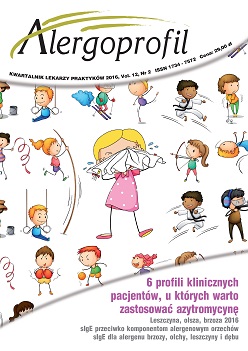House dust mites as factors allergenic
Main Article Content
Abstract
House dust mites are considered to be the most common cause of allergies and cases of asthma in our country. Recent studies indicate that dust mites produce more than 30 proteins with allergenic properties. Trigger IgE-mediated reactions by direct effects on IgE antibody synthesis and secretion of pro-inflammatory cytokines. The aim of this work was to analyze the concentrations of total IgE and specific antibodies to the house dust mite allergens. The percentage of the pathological IgE obtained in our studies has ranged between 80% and 96%. Studies have also shown that the levels of total IgE and specific IgE are influenced by the age of patients as well as concomitant diseases. The percentage of pathological IgE is higher than the value of the total IgE, which shows that not all patients concentrations of total IgE reaches values exceeding the reference range commensurate with sIgE. That is why it is important to complement the diagnosis of this allergy in patients with the normal levels of total IgE.
Downloads
Article Details
Copyright: © Medical Education sp. z o.o. This is an Open Access article distributed under the terms of the Attribution-NonCommercial 4.0 International (CC BY-NC 4.0). License (https://creativecommons.org/licenses/by-nc/4.0/), allowing third parties to copy and redistribute the material in any medium or format and to remix, transform, and build upon the material, provided the original work is properly cited and states its license.
Address reprint requests to: Medical Education, Marcin Kuźma (marcin.kuzma@mededu.pl)
References
2. Smith A., Pomes A., Chapman M.: Molecular biology of indoor allergens. Clin. Rev. Allergy Immunol. 2000, 18: 265-283.
3. Szilman P., Solarz K. (red.): Parazytologia i akaroentomologia lekarska. Śląski Uniwersytet Medyczny, Katowice 2011.
4. Hallas T.: The biology of mites. Allergy 1991, 46: 6-9.
5. Racewicz M.: House dust mites (Acari: Pyroglyphidae) in the cities of Gdańsk and Gdynia (Northern Poland). Ann. Agric. Environ. Med. 2001, 8: 33-38.
6. Henszel Ł., Kalisińska E., Kosik-Bogacka D., Kuźna-Grygiel W.: Living conditions and the acarofauna of dust collected from the apartments in North-West Poland. Alergia Astma Immunol. 2009, 14(4): 252-258.
7. Arlian L.G., Morgan M., Neal J.: Dust mite allergens: ecology and distribution. Curr. Allergy Asthma Rep. 2002, 2: 401-411.
8. Solarz K., Senczuk L., Maniurka H. et al.: Comparisons of the allergenic mite prevalence in dwellings and certain outdoor environments of the Upper Silesia (southwest Poland). Int. J. Hyg. Environ. Health 2007, 210: 715-724.
9. Solarz K.: Temporal changes in the composition of house-dust-mite fauna in Poland. Acta Zool. Cracov. 2010, 53B (1-2): 39-64.
10. Siwak E., Skotny A., Zbrojewicz E. et al.: Allergens of mites. Postępy Hig. Med. Dośw. 2014, 68: 369-374.
11. Thomas W.R., Smith W.A., Hales B.J.: The allergenic specificities of the house dust mites. Chang Gung Med. J. 2004, 27: 563-569.
12. Cui Y., Sun J., You L. et al.: Sequential epitopes of Dermatophagoides farinae allergens identified using peptide microarray-based immunoassay. Manuscript nr. IMRE-D-15-00268.
13. Pomes A., Smith A., Gregoire Ch. et al.: Functional Properties of Cloned Allergens from Dust Mite, Cockroach, and Cat. ACI International 2001, 13: 162-169.
14. Thomas W.R., Heinrich T.K., Smith W.A., Hales B.J.: Pyroglyphid house dust mite allergens. Protein Pept. Lett. 2007, 14: 943-953.
15. Jacquet A.: Innate Immune Responses in house dust mite allergy. ISRN Allergy 2013, 1-18.
16. Kowalski M., Majkowska-Wojciechowska B., Grzegorczyk J.: Stężenia alergenu roztoczy kurzu domowego DER p I w mieszkaniach łódzkich. Alerg. Astma Immun. 1996, 1: 41-46.
17. Kowalski M.: Uczulenie na roztocze kurzu domowego – kliniczne znaczenie i współczesne sposoby profilaktyki. Pol. Arch. Med. Wewn. 1992, 87: 365-371.
18. Nowicka U.: Choroby i stany przebiegające z podwyższonym stężeniem immunoglobuliny E w surowicy. Pneumonol. Alergol. Pol. 2009, 77: 533-540.
19. Kinet J.: Allergy and hypersensitivity. Curr. Opin. Immunol. 2002, 14: 685-687.
20. Wąsowska-Królikowska K.: Alergia pokarmowa. Prz. Alergol. 2004, 1(2): 49-51.
21. Łukaszyk E., Łukaszyk M., Ziętkowski Z., Bodenta-Łukaszyk A.: Markers of allergy in hematological disorders. AAI 2013, 18(4): 199-202.
22. [online: http://ecap.pl/pdf/ECAP_wyniki_pl.pdf ].
23. [online: https://woolcock.org.au/].
24. Aloszko A., Mincewicz G., Kurowski W., Wasilewska E.: Obecność roztoczy kurzu domowego w mieszkaniach chorych na całoroczny alergiczny nieżyt nosa na terenie Trójmiasta. Alerg. Astma Immun. 2004, 9(1): 33-38.
25. Solarz K., Pompa O., Asman M., Szilman E.: Ryzyko ekspozycji na roztocze kurzu domowego i inne stawonogi w trzech górnośląskich szpitalach. Alergoprofil 2010, 6(2): 23-31.
26. Rapiejko P.: Przewlekły alergiczny nieżyt nosa w przebiegu uczulenia na alergeny roztoczy kurzu domowego. Opis przypadku. Alergoprofil 2014, 10(3): 67-73.
27. Corry D.: Il-13 in allergy: Home at last. Curr. Opin. Immunol. 1999, 11: 610-614.
28. Mediaty A., Neuber K.: Total and specific serum IgE decreases with age in patients with allergic rhinitis, asthma and insect allergy but not in patients with atopic dermatitis. Immun. Ageing 2005, 31: 2-9.
29. Bożek A., Filipowska B., Starczewska-Dymek L.: Całkowity poziom IgE i obecność swoistych IgE w surowicy chorych z alergią w wieku podeszłym. AAI 2007, 12(1): 46-50.
30. Stone K., Prussin C., Metcalfe D.: IgE, mast cells, basophils, and eosinophils. J. Allergy Clin. Immunol. 2010, 125: 73-80.

